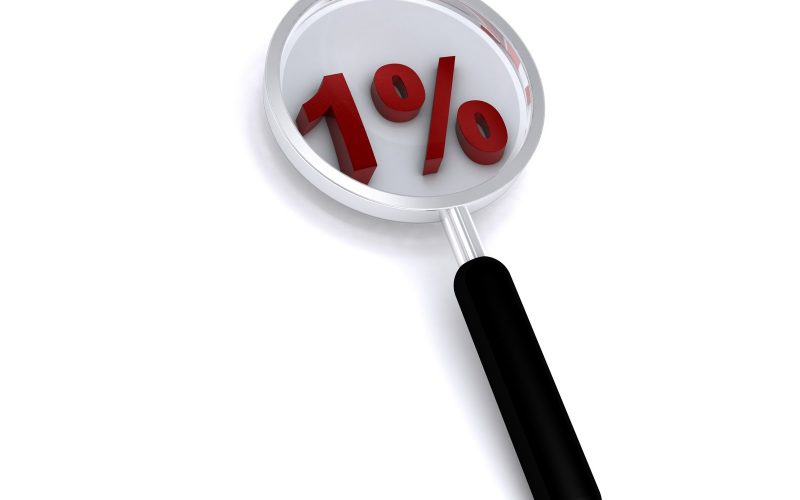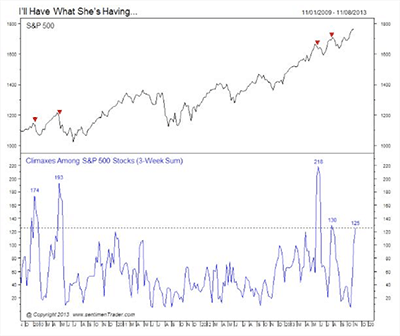“The One Percent”
by Jeffrey Saut, Chief Investment Strategist, Raymond James
December 16, 2013
Just as the commandment “Thou shalt not kill” sets a clear limit in order to safeguard the value of human life, today we also have to say “thou shalt not” to an economy of exclusion and inequality. Such an economy kills. How can it be that it is not a news item when an elderly homeless person dies of exposure, but it is news when the stock market loses two points? This is a case of exclusion. Can we continue to stand by when food is thrown away while people are starving? This is a case of inequality. Today everything comes under the laws of competition and the survival of the fittest, where the powerful feed upon the powerless. As a consequence, masses of people find themselves excluded and marginalized: without work, without possibilities, without any means of escape.
... Pope Franciscus, Jorge Mario Bergoglio 13.III.2013
I read the Pope’s words about inequality following a meeting of our newly formed Consumer Analysts Panel. The panel consists of our consumer analysts, our lodging/housing analysts, our economist, senior management of our institutional sales team, and me. Interestingly, the recurring theme over the course of said meeting was that the top 20% of wage earners are doing fine, but the bottom 20% are not. Our Hardlines Retail analyst said the more defensive the retailer, the worse the sales are. He also said that shopping at the $1 stores was doing okay. In fact, the CEO of Dollar General (DG/$60.48/Market Perform) stated even though there are 22,000 one-dollar type of stores in the U.S., the business could support another 14,000 stores. The implication is many folks have moved down the “food chain” in where they are doing their shopping. Confirming that view, our restaurant analyst noted that while “fast food” chains are doing fine, there has been an 11% contraction in dining sales with a nominal shrinkage in aggregate demand. He also said traffic is down about 3%. Our Home & Building Products analyst mentioned that at the Dixie Group (DXYN/$11.44/Strong Buy), which is a “high end” carpet manufacturer, business is soaring by 20-30% y/y and they can’t keep up with demand; a further sign the 1% is doing just fine.
Accordingly, the meeting resonated with the Pope’s inequality comments because the central theme of our “Consumer Meeting” was about how the higher wage earners are doing just fine, but the lower wage earners are not. Barron’s recently noted, “Today, the top 10% of Americans hold 74% of the nation’s wealth – up from 71.5% in 2007, and well above levels near 50% in France, 44% in the U.K., and 34% in Japan.” Moreover, production workers’ average hourly earnings are up just 2.2%, year-over-year. Indeed, the infamous “One Percent” mantra came back to mind! So who is the favored 1%? Well, last year Richard C. Morais wrote an article about a study done by The Harrison Group and American Express Publishing for Barron’s, which stated:
It’s important the public realize the much-derided 1% is a rich group, but they are nowhere near the 400 über-rich, the Larry Ellisons and Donald Trumps that make up the wealth mythology floridly living in our imagination. In actual fact, the 1% looks a lot more like “regular folk” than most of us really realize. According to the survey: 67% grew up in a middle class or poorer household, 85% made their wealth in their lifetime, 76% describe themselves as “Middle Class” at heart, 3% is the sum total of their assets that they inherited. “This is the triumph of the Middle Class,” says Jim Taylor, Vice Chairman of the Harrison Group. “Even when older, the [One Percent] don’t lose the degree with which they see themselves as the repository of the Middle Class. That means hard work. That means the value of education. That means the value of family and luck.”
This year, however, all should give thanks! Not just the 1%, but anyone that owns a house, an IRA, a 401(k), a pension plan, etc., because household net-worth is at all-time highs of $129 trillion. Further, the Wilshire 5000, which is roughly equal to the market value of all U.S. equities, is valued at $19 trillion versus its 2009 low of $7 trillion, which has an extremely positive “wealth effect” on consumption for the American consumer. This is a huge positive, as is the dramatic decline in gasoline prices. Obviously, this is a “feel good” accelerator for the American public. As my friend Barry Ritholtz writes, “The pessimists overlooked three big news stories this year.
- Americans' debt burdens are as low as they've been in a generation.
- Health care cost growth has plunged.
- The federal budget deficit has fallen off a cliff.”
Additionally, Federal outlays have declined by 1.4% m/m in November and have been flat for nearly five years, Federal tax receipts have surged by 2.8% m/m, and personal income and corporate profits have soared. The federal deficit has narrowed to less than 4.0% of GDP, and the CBO is estimating it will narrow to 3.3% in 2014. I have long argued that the equity markets do not care about the absolute of “good or bad,” but merely if things are getting “better or worse.” I have further opined that “things” are definitely getting better. In fact, I cannot remember when things have been getting better for this long! For examples, read the headlines: “Capital leaders Agree to a Deal on the Budget,” (New York Times, 12/11/13); “Wall Street Exhales as Volcker Rule Seen Sparing Market-Making” (Bloomberg, 12/11/13); the “WTO Seals Deal for First Time in 18 Years to Ease Trade Tensions” (Bloomberg, 12/7/13) ... and the list goes on. My contacts inside the D.C. Beltway tell me there is a “grand bargain” in the works because the Obama administration is afraid of the negative effects of Obamacare on the mid-term elections. No wonder the stock market has done so well and is likely to do so again in 2014. Maybe not at the same ramp rate (~25%) as this year, but certainly if earnings arrive at anywhere close to what the bottom-up, operating earnings estimates for 2014 that S&P suggests ($122.42), if the S&P 500 (SPX/1775.32) continues to trade at its current P/E multiple of 16.45x, it produces a price target of 2014 in 2014 for the SPX (16.45 x $122.42 = ~2014).
That said, while the primary trend remains “up,” there was a traders “sell signal” registered last week when the 14-day stochastic indicator fell below its moving average. Notably, this is just a very short-term trading indicator, but it was confirmed by the 125 “buying climaxes” that occurred last week. A “buying climax” happens when a stock sets a new 52-week high and then drops below where it closed the prior week (see chart on page 3). It is also worth mentioning that the SPX has closed below its 10-DMA and its 30-DMA. I had actually thought there would be more of a sell-off on Friday with Iran backing away from the talks and Syria heating up, but the SPX again held in the 1770 – 1784 support level often discussed in these missives. If that level eventually fails to hold, then the SPX’s 50-day moving average (DMA) at 1761.74 comes into play. If that “falls,” we would likely be into a full 5% (1721) to 7% (1684) correction. One more thing I think I know is that certain stocks will be sold to establish tax losses to offset gains taken in 2013. Once that selling pressure ends, there should be at least a compression bounce for those stocks. Three underperforming groups that certainly qualify for such a bounce would be the precious metals, base metals, and the coal stocks.
The call for this week: I am in Boston all week seeing accounts and speaking at an event. The event on Wall Street will be the question, “Will they taper?” I said it last summer that I didn’t think they would taper in September and probably will not taper this year. I still feel that way. If correct, the ideal trading pattern for this week would be weakness into the announcement, which would set the stage for a “no taper” rally that spills over into the Santa rally.
Copyright © Raymond James















